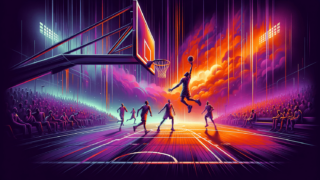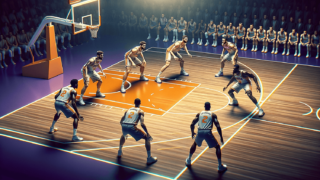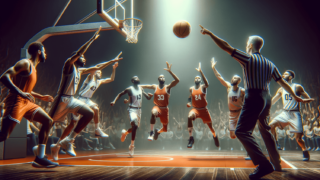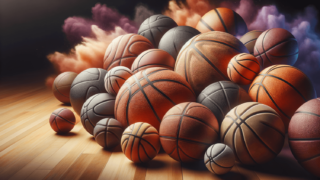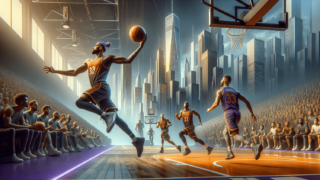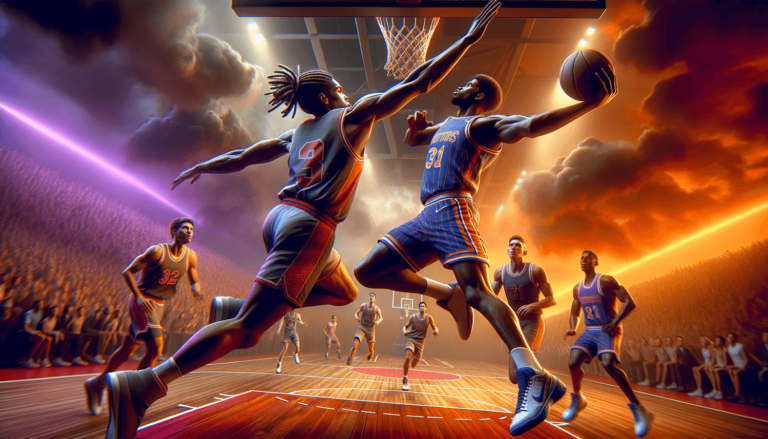
Get ready to elevate your knowledge of basketball fundamentals as we break down one of the most exhilarating defensive moves in the game: the block. Imagine charging towards the hoop, ready to score, only to have your well-planned attempt swatted away by a tenacious defender. In this blog post, we’ll explore the ins and outs of the block, from its spectacular impact on gameplay to the artistry of executing it. Dunk into a treasure trove of information and learn about the tricks and tactics employed by basketball’s most talented shot-blockers.
What Is a Block in Basketball?
A block in basketball is a defensive move where a player deflects or alters the trajectory of an opponent’s shot attempt, preventing it from reaching the basket. Blocks usually occur close to the rim, with defenders often leaping or extending their arms to disrupt the opponent’s shot. In basketball statistics, blocks are recorded in a player’s defensive stats and contribute to evaluating their overall defensive performance.
Types of Blocks in Basketball
Whether it’s a simple deflection or a full-on rejection, there are various types of blocks in basketball. Let’s swat away some misconceptions and dig into the intricacies of these different forms.
The Basic Block
An essential fundamental for all players, the basic block involves a defender rising up to meet their opponent’s shot, using their hand to deflect the ball. Timing is crucial in a basic block – aim too early or too late, and you’ll likely miss the shot; execute it just right, and you’ll leave your opponent bewildered.
The Chase-Down Block
In what is arguably one of the most exhilarating plays in basketball, a chase-down block involves a defender coming from behind their opponent to swat the shot attempt. This kind of block needs exceptional timing and athleticism, as the defender races against the clock to make their move before the opponent has a chance to score.
The Help-Side Block
This type of block occurs when a defender leaves their assigned player to come to the rescue of a teammate, helping them to prevent an opponent’s shot. The help-side block requires solid teamwork and communication, as well as a keen awareness of the game and court positioning.
Notable Shot-Blockers in the History of Basketball
Throughout the history of basketball, several players have carved their names in stone as some of the greatest shot-blockers of all time. Let’s pay homage to these legends and dive into their iconic careers.
Hakeem Olajuwon
Nicknamed “The Dream” for his unparalleled footwork, Hakeem Olajuwon is the NBA’s all-time leader in blocks. The Nigerian-American center, who played most of his career with the Houston Rockets, accumulated a staggering 3,830 blocks in his storied career. Olajuwon’s unique combination of agility, size, and timing made him an unrelenting force on the defensive end.
Dikembe Mutombo
Waving his iconic finger after blocking countless shots, Dikembe Mutombo is synonymous with elite-level shot-blocking. The Congolese-American center, who played for various teams throughout his career, is currently second on the NBA all-time blocks list, with 3,289 blocks. Mutombo’s imposing 7-foot-2 frame and intense focus on defense earned him four NBA Defensive Player of the Year awards.
Bill Russell
While blocks weren’t officially recorded during his time in the NBA, it’s impossible to discuss shot-blocking in basketball history without mentioning Bill Russell. The Boston Celtics’ legendary center was known for altering the game with his impeccable shot-blocking skills, using them to propel his team to 11 NBA championships. Russell’s defensive prowess earned him the reputation as the ultimate intimidator, anchoring one of the most successful basketball dynasties in history.
Mastering the Art of Shot-Blocking
Blocking a shot may seem like a straightforward play in basketball, but it requires careful preparation and purposeful practice. By honing your skills in these areas, you can elevate your shot-blocking game and boost your defensive contributions on the court.
Timing
The key to a successful block lies in its precise timing. Players must learn to anticipate an opponent’s shot, reacting at the split second when they initiate their shooting motion. Practicing this timing involves watching film, observing opponents’ habits, and sharpening your reflexes through drills and in-game experience.
Positioning
An excellent shot-blocker must also master the art of positioning on the court. Understanding angles and distances, as well as being able to read ball movements, are crucial skills to develop for a successful block. Proper positioning not only means being in the right place at the right time but also minimizing the risk of committing fouls.
Verticality
Jumping straight up, without leaning into the opponent, is a vital aspect of maintaining verticality during a block. By keeping your arms straight and maintaining good posture, you reduce the risk of contact and decrease the chances of being called for a foul. Practicing vertical leaps and increasing your jump height can greatly improve your shot-blocking success rate.
Common Shot-Blocking Mistakes to Avoid
No matter your skill level, shot-blocking is a challenging aspect of basketball that can be equally rewarding and frustrating. To help you avoid potential pitfalls, let’s take a look at some common mistakes players often make when attempting blocks.
Biting on Pump Fakes
A pump fake is an offensive maneuver where a player pretends to shoot, getting the defender to jump in anticipation of a block. This can lead to the defender being out of position, allowing the opponent an open scoring opportunity. To avoid falling for pump fakes, practice discipline and patience, keeping your feet on the ground until you’re confident the shot is being attempted.
Foul Trouble
Attempting blocks can sometimes lead to unnecessary fouls, especially if a player’s timing or positioning is off. Blocking an opponent’s shooting arm or making excessive contact can result in foul calls. To mitigate this risk, focus on refining your shot-blocking technique, avoiding excessive contact, and maintaining verticality when going for a block.
Chasing Every Shot
While enthusiasm for blocking shots is commendable, not every shot is blockable. Going for every shot may put you and your team at a disadvantage, as you can easily be out of position for defensive rebounds or susceptible to counterattacks. Picking your battles and remaining selective with shot-blocking attempts can help you better manage your defensive impact on the court.
Shot-Blocking’s Effect on The Game
A well-executed block can shift the momentum of a basketball game and inspire confidence in your teammates. Here are some key effects of shot-blocking on the game.
Intimidation and Altering Shots
An elite shot-blocker can change the entire dynamic of a game merely by their presence. Opponents may think twice before driving to the basket, opting for lower-percentage shots or adjusting their shooting trajectory to avoid being blocked. This psychological impact on the opposition can significantly influence the game’s outcome, making a solid shot-blocker invaluable for any team.
Fast-Break Opportunities
After swatting away an opponent’s shot, your team can push the pace and capitalize on the opponent’s disorganization to create fast-break opportunities. Blocks often leave opponents scrambling to recover, giving you and your teammates a chance to seize the moment and score easy baskets in transition.
Building Team Morale
A spectacular block can be a powerful motivator for your team. There’s something about watching a team member reject an opponent’s shot that boosts morale and ignites energy in the group. High-flying blocks can serve as fuel for your team’s fire, increasing their intensity and sparking momentum that can carry over to other areas of the game.
Block, Rebound, Dominate: Fulfilling the Defender’s Trifecta
An often-overlooked aspect of shot-blocking is securing the possession after the block. A block is only as valuable as the subsequent possession it grants your team. Let’s explore strategies to follow up your blocks and maximize their impact.
Strike a Balance: Blocking vs. Tipping
While it might be tempting to send a blocked shot into the stands, the most significant advantage comes from keeping the ball in play. By tipping or redirecting the ball rather than swatting it with full power, you increase your team’s chances of maintaining possession. Striking the right balance between blocking and tipping is an essential strategy for all shot-blockers to develop.
Teammate Communication
After a successful block, it’s essential to communicate with your teammates to secure the rebound. Alert them to the block, and direct them to the ball’s anticipated trajectory. Prompt communication can significantly increase your team’s chances of recovering the ball and advancing to offense.
Rebounding Positioning
Following a block, quickly re-establish your positioning for a defensive rebound. Locate the ball, box out any nearby opponents, and gather the loose ball. Practicing your ability to transition from shot-blocking to rebounding will vastly improve your defensive contributions to your basketball team.
Shot-Blocking in Different Basketball Leagues
Apart from the NBA, other basketball leagues around the world also house impressive shot-blockers, further showcasing the beauty of this defensive technique. Let’s take a look at how shot-blocking influences diverse leagues and styles of play.
FIBA and EuroLeague
In international basketball, whether it’s continental club competitions like the EuroLeague or national team events organized under FIBA, shot-blocking is equally crucial. Defensive specialists who can protect the rim and contest shots are highly sought after in these leagues, and rules governing goaltending are slightly different, offering unique challenges and opportunities for shot-blockers.
Women’s Basketball
Excellent shot-blocking transcends gender in the realm of basketball. The Women’s National Basketball Association (WNBA) and top-tier college basketball, such as NCAA Division I, have a wealth of dominant shot-blockers. Players like Margo Dydek and Brittney Griner have made a name for themselves with their extraordinary shot-blocking abilities, proving that athletic prowess and elite rim protection know no boundaries.
Streetball and Outdoor Courts
Shot-blocking extends beyond professional basketball in indoor arenas, as you can also find it happening on streetball courts and outdoor playgrounds worldwide. Blocking shots here has a slightly different flavor due to factors like court surface, lighting, and varying levels of athleticism. Still, it continues to be an essential and exciting facet of the game, whichever court you’re on.
Notable Shot-Blocking Awards and Accolades
Given the influential nature of blocks in basketball, numerous awards and accolades celebrate the achievements of the sport’s best shot-blockers. Here are some of the most prestigious titles tied to this renowned defensive prowess.
NBA All-Defensive Team
The NBA All-Defensive Team is an annual honor awarded to the top defenders in the league. Although the award covers all aspects of defense, many players known for their shot-blocking prowess have made multiple appearances on this prestigious list. Being named to an All-Defensive team is a recognition of a player’s tenacity and ability to impact the game from the defensive end.
NBA Defensive Player of the Year
Another coveted accolade to honor a player’s defensive impact is the NBA Defensive Player of the Year award. This award is given to a single player whose defensive contributions have had the most substantial effect on their team’s performance. Many shot-blockers, such as Dikembe Mutombo and Rudy Gobert, have been named Defensive Player of the Year, emphasizing how crucial blocking shots is for overall defensive excellence.
College Basketball Defensive Awards
In college basketball, various organizations recognize stellar defensive performances, among which shot-blocking stands out. The awarding bodies include the National Association of Basketball Coaches (NABC), the NCAA, and media outlets like ESPN. Being acknowledged for defensive skills early in a player’s career can set the stage for future success in professional leagues and beyond.
Frequently Asked Questions
As you continue to explore the fascinating world of shot-blocking in basketball, you may have additional questions or need clarification on specific topics. We’ve compiled a list of frequently asked questions to address your curiosities and help you better understand the intricacies of blocks in basketball.
What’s the difference between a block and a goaltending violation?
A block is a legal defensive move in which a player deflects or redirects an opponent’s shot, while a goaltending violation occurs when a defensive player interferes with a shot that is on its downward arc towards the basket or has already touched the backboard. Goaltending results in an automatic two points for the shooting team. The distinction between a block and goaltending depends on the timing and trajectory of the shot attempt.
Is it better to have more blocks or less fouls?
Both blocking shots and avoiding fouls are essential aspects of solid defense. However, achieving a balance between the two is crucial, as aggressive shot-blocking attempts can lead to excessive fouls. A good defender should prioritize clean, well-executed blocks while staying mindful of their opponents’ movements to minimize the risk of committing fouls.
What are the primary skills needed to be a great shot-blocker?
The primary skills necessary to become a successful shot-blocker include impeccable timing to anticipate and react to an opponent’s shot, proper positioning on the court, and verticality when leaping to avoid contact and fouls. Additionally, height, wingspan, foot speed, and basketball IQ can significantly enhance a player’s shot-blocking prowess.
Do I need to be tall to be a good shot-blocker?
Although being tall can be an advantage in shot-blocking, it’s not a prerequisite for success. Players with shorter statures can compensate for their lack of height with exceptional speed, quick reflexes, court awareness, and instinctual movement. Focusing on developing proper shot-blocking technique, timing, and positioning can help shorter players excel in their defensive roles.
What is the most blocked shots recorded in a single NBA game?
The record for the most blocked shots in a single NBA game is held by Elmore Smith, who blocked 17 shots playing for the Los Angeles Lakers on October 28, 1973. This impressive display of shot-blocking prowess remains unbroken to this day.
What is the strategy for securing the ball after a block?
Striking a balance between blocking and tipping to keep the ball in play is essential for securing possession after a block. Additionally, communicating with teammates, quickly re-establishing rebounding positioning, and boxing out opponents can further increase the odds of retaining possession and capitalizing on your successful block.
How can I practice shot-blocking outside of games?
Practicing shot-blocking outside of games can involve a diverse set of drills focusing on leaping ability, strength, and timing. Vertical jump exercises, sprint and agility drills, and on-court drills with shooting partners can help you improve your blocking skills. Studying and analyzing game film, particularly of accomplished shot-blockers, can also be beneficial for refining your technique.
Does a block count as a turnover in basketball statistics?
A block does not directly count as a turnover in basketball statistics. However, it can potentially lead to a turnover if the blocked shot results in a change of possession, such as when the defensive team recovers the ball after a block.
What is the role of the weak-side defender in blocking shots?
The role of the weak-side defender in shot-blocking is to provide help defense for their teammates when opponents try to score from the strong side. This is often referred to as a help-side block. The weak-side defender must be aware of court positioning, anticipate an opponent’s shot, and time their jump to execute an effective help-side block.
Why is it important to remain disciplined when attempting a block?
Staying disciplined when attempting a block is crucial to avoid falling for pump fakes, committing unnecessary fouls, and chasing every shot. By maintaining focus and patience, and prioritizing shot-blocking technique and timing, a disciplined defender can maximize their defensive impact on the court and avoid putting their team in disadvantageous situations.
How can I avoid being called for a foul when attempting a block?
To avoid being called for a foul when attempting a block, focus on maintaining verticality by jumping straight up without leaning into the opponent. Keep your arms straight and avoid contact with the opponent’s shooting arm. Refining your shot
Featured Posts
- No pillar pages found.
